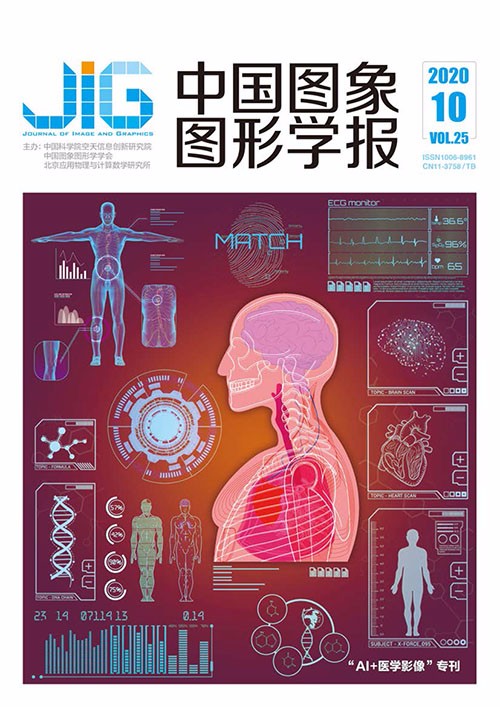
融合密集残差块和GAN变体的医学图像非刚性配准
摘 要
目的 现有的医学图像配准算法在处理较大非刚性形变的医学图像时,存在配准精度低和泛化能力不足的问题。针对该问题,提出结合密集残差块和生成对抗网络(generative adversarial network,GAN)的图像配准方法,用于多模态医学图像的非刚性配准。方法 将密集残差块引入到生成器,提取待配准图像对的更多高层特征,从而提高配准精度;在GAN中采用最小二乘损失代替逻辑回归构造的交叉熵损失,由于最小二乘损失的收敛条件更严格,同时能缓解梯度消失和过拟合,从而提高配准模型的稳定性;在判别器网络中引入相对平均GAN(relative average GAN,RaGAN),即在标准判别器的基础上增加一项梯度惩罚因子,降低判别器的判别误差,从而相对减少配准模型的配准误差,有助于稳定配准精度。结果 在DRIVE(digital retinal images for vessel extraction)数据集上进行训练和验证,在Sunybrook Cardiac数据集和Brain MRI数据集上进行泛化性能测试,并与几种主流医学图像非刚性配准算法进行对比实验,表明,本文配准模型在精度和泛化能力上均有一定程度的提升,相比其他方法,视网膜图像、心脏图像和脑部图像的配准Dice值分别提升了3.3%、3.0%、1.5%。结论 提出的配准方法能够获取更多高层特征信息,从而提升配准精度;同时基于最小二乘法构建损失函数并对判别器进行加强,能够使得配准模型在训练阶段快速收敛,提高了配准模型的稳定性和泛化能力,适合存在较大非刚性形变的医学图像的配准。
关键词
Non-rigid medical image registration based on residual-in-residual dense block and GAN
Zhang Guimei, Hu Qiang, Gong Lei(Institute of Computer Vision, Nanchang Hangkong University, Nanchang 330063, China) Abstract
Objective Medical image registration is an important research task in the field of medical image analysis, which is the basis of medical image fusion and medical image reconstruction. Conventional registration methods that build loss function based on normalized mutual information by using iterative gradient descent to achieve registration tend to be time consuming. The existing deep learning-based medical image registration methods have limitation in registering medical images with large non-rigid deformation, which cannot achieve high registration accuracy and have poor generalization ability. Thus, this paper proposes a method to register multi-modal medical images by combining residual-in-residual dense block (RRDB) with generative adversarial network (GAN).Method First, RRDB are introduced to the standard generator network to extract high-level feature information from unpaired image pairs; thus, registration accuracy is improved. Then, a least-squares loss is used to substitute cross-entropy loss constructed by the logistic regression objective. The convergence condition of least-squares loss is strict and promotes the model to reach convergence at the optimal parameters, which can alleviate gradient disappearance and overfitting; thus, the robustness of model training is enhanced. In addition, relative average GAN (RaGAN) is embedded into the standard discriminator network, namely, adding a gradient penalty in the discriminator network, which reduce the error of discriminator to estimate the relative true and false probability between the fixed image and moving image. The enhanced discriminator can help the generator to learn clearer and texture information; therefore, the registration error can be decreased, and the registration accuracy can be stabilized.Result This registration model is trained and validated on DRIVE(digital retinal images for vessel extraction) dataset. Generalization performance tests are performed on Sunybrook Cardiac Dataset and Brain MRI Dataset. Compared with state-of-the-art registration methods, extensive experiments demonstrate that the proposed model achieves good registration results; both registration accuracy and generalization ability have been improved. Compared with the basic literature, the registration Dice values of retinal images, cardiac images, and brain images are improved by 3.3%, 3.0%, and 1.5%, respectively. According to the stability verification experiment of the registration model, as the number of iterations augments, the Dice value of this paper gradually increases, and the change is more stable than that of baseline literature. The number of iterations in this paper is 80 000, whereas that of baseline literature is 10 000. This verification experiment shows that this registration model has been effectively improved in the training phase; not only the convergence speed is accelerated but also stability is higher compared with that of baseline literature. Conclusion The proposed registration method can obtain high-level feature information; thus, the registration accuracy is improved. Simultaneously, the loss function is built on the basis of the least-squares method, and the discriminator is also strengthened, which can enable the registration model to quickly converge during the training phase and then improve model stability and generalization ability. This method is suitable for medical image registration with large non-rigid deformation.
Keywords
medical image non-rigid registration generative adversarial network(GAN) residual-in-residual dense block(RRDB) least square loss relative average GAN(RaGAN)
|



 中国图象图形学报 │ 京ICP备05080539号-4 │ 本系统由
中国图象图形学报 │ 京ICP备05080539号-4 │ 本系统由